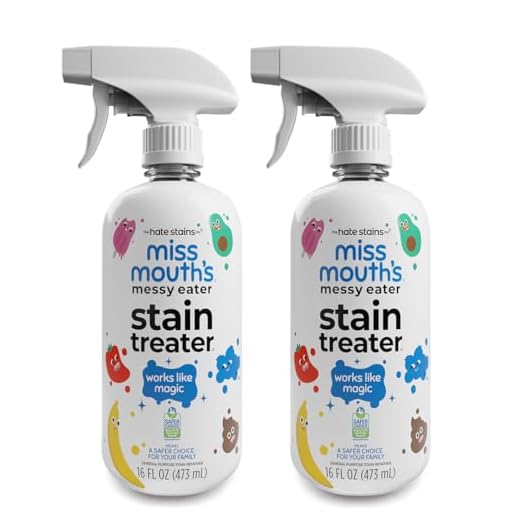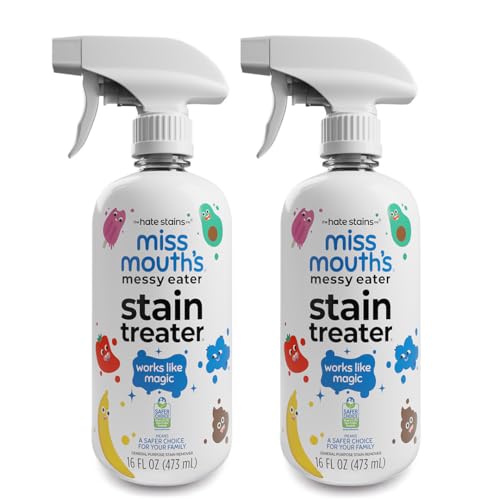

Act quickly: the sooner you treat a stain, the better your chances of removal. Begin by blotting the affected area gently with a clean cloth or paper towel to absorb excess liquid without rubbing it in further.
Next, apply a generous amount of cold water directly to the stain. Avoid hot water, as it can set the pigmentation. If available, a stain remover or a mixture of dish soap and hydrogen peroxide can be effective. Mix these ingredients in a bowl, then apply the solution to the stain using a clean cloth.
Allow the solution to sit for around 30 minutes, then rinse thoroughly with cold water. If the stain persists, repeating the process may yield better results. For particularly stubborn marks, consider a commercial stain remover specifically formulated for delicate materials.
Always test any cleaning solution on a hidden area of the fabric first to ensure it won’t cause damage. After treatment, launder as usual, but avoid drying in a machine until you’re certain the stain is completely removed, as heat can cause it to set permanently.
Immediate Steps to Take After the Spill
Act swiftly. The quicker you respond, the higher the chances of successfully removing the blemish. Begin by dabbing the stain with a clean, dry cloth or paper towel. Avoid rubbing, as this may push the liquid deeper into the fibers.
Follow These Steps:
- Blot the area gently to absorb excess liquid.
- Sprinkle salt or baking soda on the stain to help absorb moisture and reduce discoloration.
- Leave the absorbent material for about 5-10 minutes, then brush it off carefully.
Next Actions:
- Rinse the affected area with cold water from the back of the fabric to push the stain forward.
- Apply a stain remover or a mixture of dish soap and hydrogen peroxide, letting it sit for 30 minutes.
- Wash the garment in cold water; check the stain before drying. If it persists, repeat the treatment.
For those seeking a powerful cleaning solution, consider using a best comercial pressure washer to tackle tough stains on various fabrics, but ensure compatibility first.
Best Household Items for Stain Removal
Baking soda serves as a powerful abrasive and deodorizer. Mix it with water to form a paste, apply it to the affected area, and let it sit for about 30 minutes before rinsing.
White vinegar is an excellent natural remedy. Combine equal parts vinegar and water, apply it to the stain, and blot with a clean cloth. This solution works well on various types of discoloration.
Dish soap can be quite effective. Mix a few drops with warm water, apply it to the stain, and gently scrub with a soft brush or cloth. Rinse thoroughly afterward.
Lemon juice acts as a natural bleaching agent. Apply it directly to the stain and expose it to sunlight. This method is particularly useful for organic stains.
Salt and Club Soda
Salt absorbs moisture and can help lift stubborn marks. Sprinkle salt on the stain immediately, then rinse with cold water after a few minutes.
Club soda is another handy item. Pour it directly onto the stain and blot with a cloth. The carbonation helps to lift the stain from the fabric.
Hydrogen Peroxide
Hydrogen peroxide is a versatile cleaner. Use a 3% solution, apply it to the stain, and let it sit for about 10 minutes before rinsing. This method is particularly effective on protein-based stains.
Techniques for Blotting and Rinsing
Blot the stain immediately using a clean, dry cloth or paper towel. Avoid rubbing, as this can spread the liquid and worsen the mark. Instead, gently press the cloth onto the area to absorb as much of the liquid as possible.
Once the initial absorption is complete, rinse the affected area under cold running water. Hold the fabric with the stained side facing down, allowing the water to flow through the material. This method prevents the stain from setting deeper into the fibers.
For effective results, continue blotting and rinsing until the water runs clear. If necessary, repeat this process multiple times, using a fresh cloth for each attempt to ensure optimal absorption.
After rinsing, allow the fabric to air dry. Avoid using heat, as it may set any remaining stain. Once dry, check the area; if any discoloration persists, consider applying a stain remover suitable for the fabric type.
Using Commercial Stain Removers: What to Look For
Prioritize stain removers that are specifically formulated for tough marks. Look for products containing enzymes, as they effectively break down organic compounds found in many beverages. Check labels for compatibility with delicate fabrics, ensuring the solution won’t compromise the integrity of your clothing.
Consider options that offer dual-action capabilities–those that not only target discoloration but also prevent future stains. Some removers feature a built-in fabric conditioner, which can help maintain the shirt’s texture and appearance.
Evaluate the product’s pH level; neutral or slightly acidic formulations are gentler on fabrics compared to highly alkaline options. Additionally, search for stain removers that are free of bleach or harsh chemicals, which can cause fading or damage to fibers.
For added convenience, choose spray or pen applicators that allow for precision application directly onto the affected area. This minimizes waste and ensures effective treatment right where it’s needed.
Lastly, review customer feedback and expert recommendations to identify products with proven results. This will guide you toward reliable solutions that deliver on their promises, making the cleanup process more efficient.
Washing instructions for treated shirts
Use cold water for rinsing treated garments as hot water can set stains. Always check care labels for specific guidelines regarding washing temperatures and methods.
Separate items by color and fabric type to avoid damage. For treated shirts, hand wash or use a gentle cycle in the washing machine to preserve the fabric’s integrity.
Do not overload the washing machine; this ensures that each piece gets adequate water and detergent circulation. Use a mild detergent specifically designed for delicate fabrics.
For best results, air dry the shirts. If using a dryer, select a low heat setting to prevent shrinking and maintain the treatment’s effectiveness.
| Washing Step | Recommendation |
|---|---|
| Rinsing | Cold water |
| Washing Method | Gentle cycle or hand wash |
| Detergent | Mild detergent for delicate fabrics |
| Drying | Air dry or low heat in dryer |
Inspect the item after washing. If any stains persist, treat them again before drying, as heat can make stains permanent.
Preventive measures for future spills
To safeguard garments against the risk of staining, consider adopting these proactive strategies:
- Wear darker colors or patterns during gatherings where spills are likely.
- Utilize wine glasses with wider bases to minimize accidental tipping.
- Establish a dedicated area for drinking; keep beverages away from food and fragile items.
- Use coasters to provide a stable surface and reduce the chance of spills.
- Incorporate tablecloths or placemats to offer an extra layer of protection.
- Invest in stain-resistant fabrics for frequently worn attire.
Additionally, keep a small emergency kit handy with the following items:
- Stain remover pen for immediate touch-ups.
- Portable blotting cloths that absorb moisture quickly.
- Plastic wrap to cover potential spills until proper cleaning can be performed.
Regular cleaning and proper care of garments can also enhance their resilience against potential stains. Store clothes in a dry environment to prevent any pre-existing spots from worsening. Following these guidelines will significantly reduce the likelihood of encountering troublesome marks in the future.






